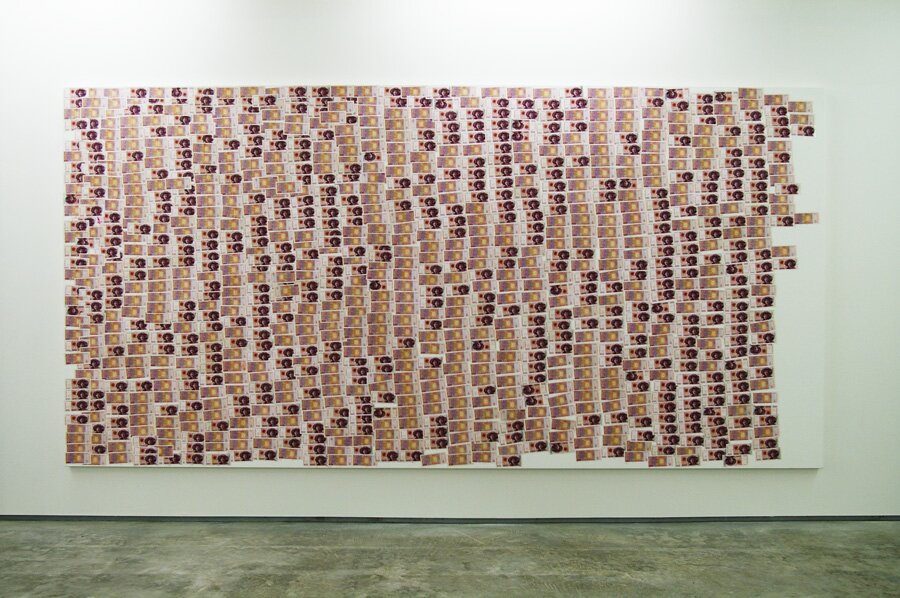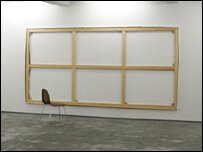Larceny of Artful Bank Notes in Norway
Posted by michelle on 01 Mar 2007 at 08:12 pm | Tagged as: responses/reviews

A couple of criminals in the plucky country of Norway decided to cut up a work of art made entirely of 100,000 Norwegian Kroner [the equivalent of $16,300]. Yesterday, some sticky fingers swiped a couple of Picasso paintings to the tune of $66 million American dollars. Oof. This hot artistic crime wave suggests a short contemplation of the ambit of value in the upper echelon of the art world. Norwegian artist Jan Christensen knew the gamble he was taking when he constructed this tempting piece of work. Relative Value sold at its face value prior to the theft from Gallery MGM in Oslo. I conducted a short online interview with Jan a few days ago. Let’s see what he had to say about high crimes, consumerism and counterfeit intelligence:
EMV: How long was the artwork installed before it was stolen?
JC: The exhibition opened January 27, so it was installed for a little less than a month.
EMV: The BBC said the culprits “cut” the notes off the canvas, how did you attach them together?
JC: The notes were glued onto the canvas with wallpaper glue, which is water-based glue. The stretchers measure 2 x 4 meters so the whole thing would have been impossible to sneak out into the street and even put in an average truck. The canvas was stitched onto the stretchers leaving the burglars with no time to properly unstitch it from the time of the alarm going off. Within 12 minutes the security service arrived and the burglars were already gone. The only way for them to move this fast would be to cut the canvas along the stretcher.
EMV: For the general public, it seems that art prices can be arbitrary. Did you consider using counterfeit notes? How does this piece fit in with your previous artwork?
JC: The art marked is not necessarily arbitrary, but the marked is so small that there are ways of manipulating it. The art marked also has weird logics which might not work the way we’re used to the stock exchange working, and there is a lot of psychology, stress and personal feelings and engagement involved in the art marked which makes it complicated and sometimes not so transparent as one might think art could be. It is not. I never considered using counterfeit money simply because I could not see how that would by any means reflect any of the ideas which this piece seemed to hold, and which causes such interest. The piece was in many ways devoid of artistic brilliance or content apart from the face value of the notes, though still an artwork because it had been so carefully arranged and placed within the situation of the gallery – like a hypothetical experiment of what it means to see a piece of art that proves to everyone what it’s worth, while being partly inaccessible unless one goes to such steps which we have seen here. And I wanted to avoid pricing my own art, therefore basically exchanging it rather than selling it, and the idea was that the piece would then actually have been given its real price (value) in the future if it was ever resold or appeared in an auction. Which still would be a relative value only. But which we will never know now. Still the piece seems to live on, like a myth.The work follows a more general attitude I have of challenging the established notions of our culture, customs, psychology and such. It sort of follows other doubtful, dark pieces which hold failed, negative, pessimistic beliefs in themselves and also mocks the role of the the artist as someone with anything to say. Relative Value was in many ways a big jab at anybody who would come close, violently cancelling out the idea of profit and success which usually inspires our intentions, creating a big black hole of collapsing logic.
EMV: I really loved the image of the canvas frame devoid of notes, somehow the criminals didn’t feel like taking it off the wall? Or did the gallery put the frame back in place for effect?

JC: The gallery employees had not yet touched the painting yet by the time those photos of the stretchers devoid of the money was taken, to secure any traces or prints from the culprits. The frame was actually better fixed to the wall than one might think, in order to withstand people touching and by accident making such a big canvas fall down.
woo.. we spot on the same topic, but my translation is not that good. anyway, what a funny piece of silly art.
Generic levitra….
Experiencing levitra. Levitra paypal. Viagra cialis levitra buy cheap cialis buy ciali. What is levitra. How long does levitra last. Levitra….